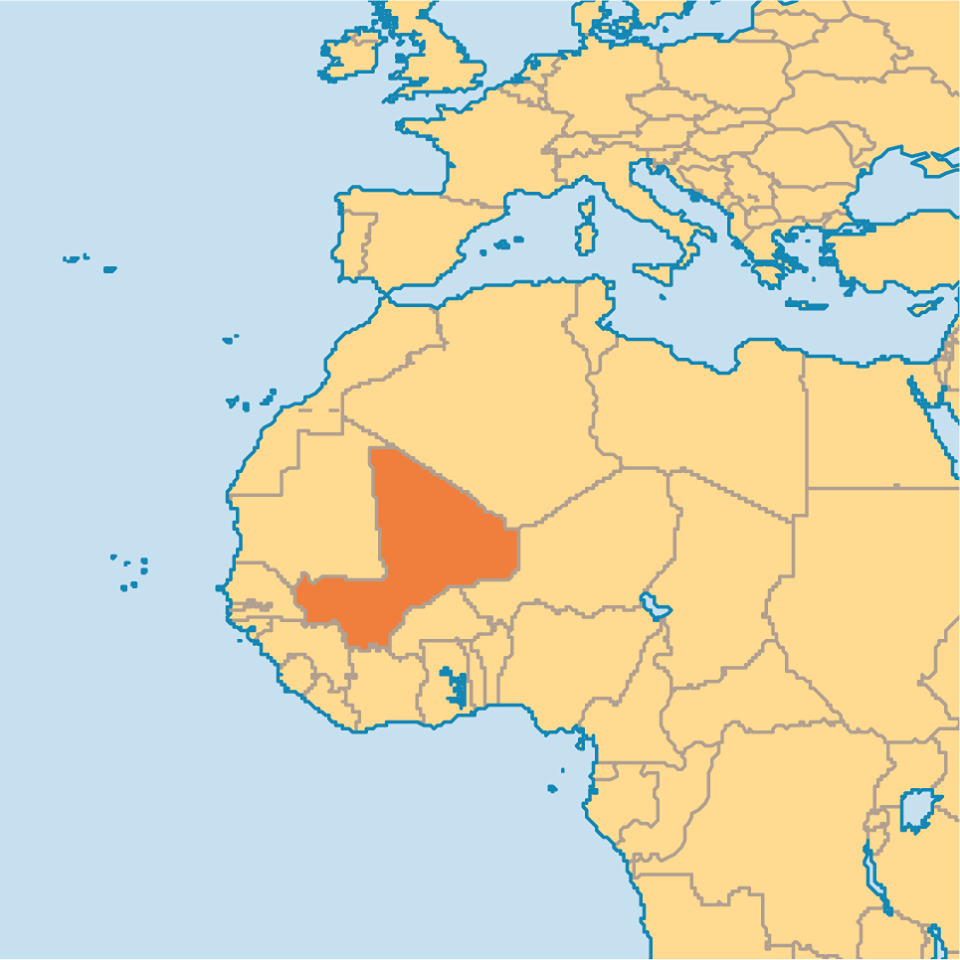
Mali’s location in Africa.

History
Mali is the heir to the succession of ancient African empires—Ghana, Mande (Malinke) and Songhai—that occupied
the West African savannah. These empires controlled Saharan trade and were in touch with Mediterranean and
Middle Eastern centers of civilization.
The Ghana empire, dominated by the Soninke or Sarakole people, was centered in the area along the modern-day
Mali- Mauritania border. It was a powerful trading state from 700 to 1075 A.D.
In 1235, the Malinke people of the small state of Kangaba became involved in a struggle for independence. Their
leader, a young man named Sundiata Keita, fielded an impressive army to meet the intruding Tekrur forces. The
decisive battle was fought on a plain just north of present-day Bamako, and Sundiata emerged victorious.
Building on this success, Sundiata established the Mali Empire, one of the great empires of that era. After his
death, his successors continued the expansion of the empire in both wealth and territory.
The zenith of Mali’s power and prestige occurred during the reign of Mansa Kankan Musa from 1307 to 1332.
Covering more than 3 million square kilometers, the empire centered around the great bend of the Niger River and
dominated the profitable trade between North and sub-Saharan Africa.
The rulers of Mali and their followers were converts to Islam, and Mansa Musa became one of the legendary
leaders of that faith. Timbuktu, the empire’s capital, became a center of Muslim scholarship, with a university
containing libraries unequaled anywhere in Africa or Europe at that time. The Mali Empire began a slow decline
after Mansa Musa’s reign but remained powerful into the middle of the 16th century.
The Songhai Empire, with its capital in Gao, predominated throughout the 16th century. Its great builders, Sunni
Ali and Askia Mohamed, were equal in historical importance to Sundiata and Mansa Musa. At its peak, under Askia
Mohamed, the Songhai Empire encompassed the Hausa States as faras Kano (in modern-day Nigeria) and northern
Cameroon. Timbuktu remained a center of commerce and Islamic faith throughout the period. The Songhai Empire was
destroyed in 1591 by a Moroccan invasion directed by Djoudder.
French intrusions into present-day Mali began in about 1854. It took approximately 50 years of battles and
broken treaties for the French to finally subjugate the Malian people. The campaign ended with the capture of
the Malinke leader Samory in 1898. Colonialism broke up traditional African patterns, replacing egalitarian
relationships with those of dependence on European powers. It also set in motion some negative forces, such as
one-crop economics, and established unrealistic political boundaries that have created significant challenges
for today’s independent African governments.
Following Mali’s independence from France in 1960, the new government, under the leadership of Modibo Keita,
moved quickly to place Malians in charge of all public institutions.
In November 1968, a military coup put Lieutenant Moussa Traoré in power, a position he held until 1991. At that
point, a democratic revolution led to the creation of a new Constitution, and the first democratically-elected
president (Alpha Oumar Konaré), in 1992 and again in 1997.
Government
Since the democratic revolution of 1991, the Malian government has become a model of democracy and peace in an
otherwise troubled area of West Africa. The current president, Amadou Toumani Touré, was elected in 2002 and
re-elected in April 2007.
The government of Mali has struggled to address many problems, most notably the prolonged Tuareg rebellion.
Despite a 1992 peace treaty, clashes continued in the northern provinces of Timbuktu and Gao. Since 1995,
however, there has been a marked decrease in Tuareg-related violence, thanks in part to former Prime Minister
Ibrahim Boubacar Keita’s efforts to establish a lasting peace. The 1994 devaluation of the Malian currency, the
CFA franc, coincided with a series of droughts, floods, and student strikes to lower the standard of living of
many Malians, putting pressure on the government to address the country’s development needs.
Economy
Mali is among the poorest countries in the world, and is heavily dependent on foreign aid. Roughly 75 percent of the population is earning less than $1 per day. Nearly 80 percent of the labor force is engaged in subsistence agriculture, including farming and fishing, mostly along the Niger River Delta. Industrial activities include gold extraction, cash crop production (cotton and rice), and processing of farm commodities. The economy is expected to grow 5 percent per year for the next several years. In 2010 the per capita gross domestic product stood at $380. The composition of GDP by sector is 36 percent agriculture, 22 percent industry, and 33 percent services.People and Culture
There are more than 20 major ethnic groups in Mali, each with a distinct language, geographic region, and social
infrastructure. Approximately 50 percent of the population belongs to the Mandé group, which include the
Bambara, Malinké, and Sarakolé. Other groups include the Peul (17 percent), Voltaic (12 percent), Songhai (6
percent), and Tuareg and Moor (10 percent). Ninety percent of the population is Muslim, with about 9 percent
following traditional African beliefs and 1 percent practicing Christianity. Though the country’s official
language is French, the most widely spoken languages belong to the Mande group, with 60 percent of the
population speaking Bambara. Other languages, such as Fulani and Songhai, are also widely spoken in certain
geographical areas.
Environment
Mali covers an area greater than New Mexico, Oklahoma, and Texas combined. It is landlocked, bounded by Algeria
and Mauritania to the north, Senegal to the west, Guinea, Côte d’Ivoire, and Burkina Faso to the south, and
Niger to the east. The country is mostly flat, except in the south where the Manding Mountains rise; and in the
east, featuring the
Bandiagara plateau and the Hombori Mountains. Central Mali consists of flood plains of the Niger Delta, while
the northern part of the country lies within the Sahara Desert. Mali has two major rivers, the Niger and the
Senegal.